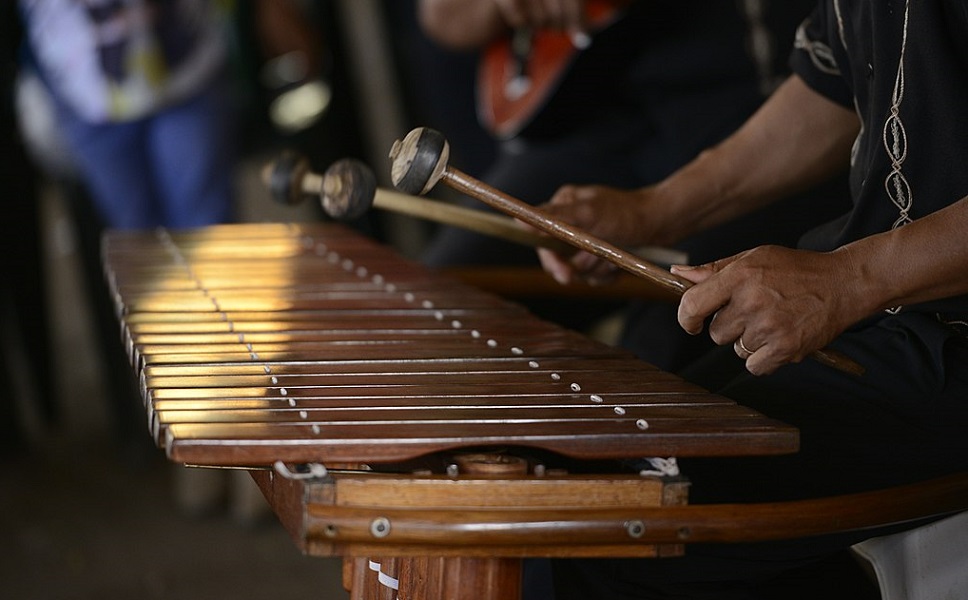
People’s culture matters! And needs the people’s protection. The first time I learned this was in the 1980s Sandinista Nicaragua, but it’s universal, including here in the U.S.
It was in the 1980s when I was trying to bring a homemade wooden marimba from Nicaragua to the U.S. that I first learned of cultural hegemony, cultural expropriation, and the urgent need to preserve cultural heritage.
As with today’s Sandinista administration, the newly victorious Sandinista revolutionary government of the 1980s was busy rebuilding Nicaraguan society. All social plans were geared toward protecting and advancing the wellbeing of the people. Every aspect of society was under discussion. Rebuilding and new construction flourished. Popular plans for literacy, education, healthcare, housing, water works, agriculture, electrification, social rights, and culture too, were feverishly being unfolded and carried out. This despite constant U.S. sabotage and bombardment, both directly and by proxy death squads and militias trained and funded by the U.S. (under President Ronald Reagan at the time) and other northern hemisphere powers.
As with Nicaragua of the 1920s, as with the USSR, Cuba, Vietnam, Iran, Guatemala, Chile, and many other countries that at various times sought to use their resources to benefit their own people rather than a thin layer of rapacious capitalists, the threat to capitalism of a thriving socialist-led government could not be tolerated by capitalist powers who were worried by the good example of 1980s Sandinista Nicaragua. The Contra-funding Reagan administration bombed rural health clinics, detonated mines in the Pacific harbor serving the capital Managua, cut off needed trade, and committed many other such tricks and abuses.
This was a time when internationals of conscience organized people-to-people aid to the just-birthed revolution. Engineers, scholars, educators, brick-makers, anyone who could turn their skills to aid the country, traveled there to work directly and fundraised for projects to support the needed work.
Being a nurse, I joined the Committee for Health Rights in Central America, a national network of medical workers collecting donations of medical supplies and attending international conferences of medical workers hosted by the Sandinista-led Ministry of Health in Nicaragua.
Around that time I was also volunteering with a Salvadoran pro-FMLN organization (Farabundo Martí National Liberation Front) led by Salvadoran expatriates and refugees. Some of us formed a music group to sing and play popular songs at fundraisers and parties. My Salvadoran comrades asked me to bring back with me a homemade marimba (a wooden xylophone long popular in rural areas of Central American countries) made by Salvadoran refugees in Nicaragua as a gift to our musical group back in the U.S.
Now, as I visited Nicaragua for a medical conference, the Salvadorans taking refuge in Nicaragua entrusted me with bringing their gift to their co-nationals in the U.S.
I soon found out that the marimba was a cultural patrimony with legal recognition by the Nicaraguan government, which meant there were certain legal requirements that had to be fulfilled to allow me to take the marimba out of the country. The implicit question was: “How do we know you’re not going to take this homemade Indigenous instrument and sell it for your personal gain?” Indeed, why should the government simply take my word for it that I was acting in the spirit of friendship and cooperation with my Salvadoran colleagues, even with the papers of recommendation and authentication from the Salvadoran comrades in the U.S. and in Nicaragua? My request to transport one musical instrument hardly approached the level of theft committed by wholesale imperialist plunderers. Nonetheless, the legal strictures were in place to protect the people’s culture—and that’s what mattered most.
Understandably, a waiting period was required, to allow for an investigation and certification of the authenticity of the papers and of the provenance of the marimba. My family back home was not pleased with the unanticipated extension of my stay in Nicaragua, but I had to wait for approval of the paperwork to bring the marimba back with me.
“Why such a fuss over a humble set of wooden keys and mallets?” I even asked myself.
I came to find out that Western European and North American militarists, adventurers, enslavers, and imperialists of various occupations have for centuries committed grand theft of sacred and non-sacred properties of the peoples of subjugated countries around the globe.
Robbing bodies from graves, sacred items from places of worship and other communal sites, and household items from people’s homes, was the trophy-hunting and souveniring sideline of capitalist conquistadors. The theft of cultural patrimony is part and parcel of the dismantling of proud millennia-old cultures and the imposition of Christianity and Western (read European and U.S.) regimes. The museum industry in Europe and North America is more and more being pressured to reckon with its legacy of iniquitous cultural thievery.
In his book The Brutish Museum: The Benin Bronzes, Colonial Violence and Cultural Restitution, British archeology professor and museum curator Dan Hicks translates this quote from Discours sur le colonialisme (Discourse on Colonialism), a 1955 essay by Martinican communist writer and politician Aimé Césaire:
“And what of the museums, of which Europe is so proud? It would have been better, all things considered, if it had never been necessary to open them. Better if the Europeans had allowed the civilizations beyond the Continent of Europe to live alongside them, dynamic and prosperous, whole and unmutilated. Better if they had let those civilizations develop and flourish rather than offering up scattered limbs, these dead limbs, duly labeled, for us to admire…. Here in the museum, the rapture of self-gratification rots our eyes. Here, a secret contempt of others dries up our hearts. Here racism, no matter if it is declared or undeclared, drains all empathy away. No, in the scales of knowledge, the mass of all the museums in the world could never outweigh a lone spark of human empathy.”
As Jim Hightower recently pointed out about the British royal crown, it is a “solid gold, ermine-lined bonnet encrusted with a world of slave-mine precious jewels—2,800 diamonds, 17 sapphires, 11 emeralds, and 269 pearls.” If you’re a museum lover as I am, facts such as these should give us pause and spur us to support movements for reparations and restitution.
That humble homemade marimba was falling apart by the time I got it stateside, but my comrades were thrilled to receive it. The lesson has stuck with me, that cultural expropriation directly links with racism and colonialism and has to be guarded against in all forms. Culture is indeed a dimension of struggle.
We hope you appreciated this article. At People’s World, we believe news and information should be free and accessible to all, but we need your help. Our journalism is free of corporate influence and paywalls because we are totally reader-supported. Only you, our readers and supporters, make this possible. If you enjoy reading People’s World and the stories we bring you, please support our work by donating or becoming a monthly sustainer today. Thank you!












Comments